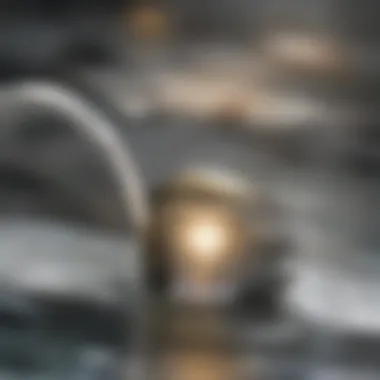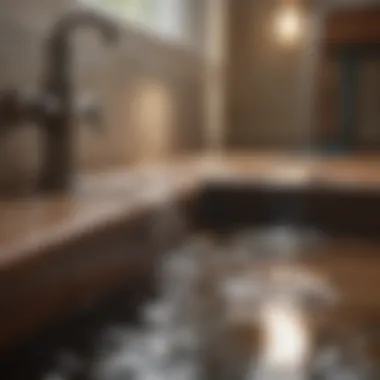Understanding and Resolving Sink Drain Issues Effectively


Intro
Sink drains are vital components in our homes. They serve as a conduit to remove waste water efficiently. Yet, many homeowners encounter problems with their sink drains at some point. These issues can lead to unsightly messes, unpleasant odors, and emergency repairs. Understanding the possible causes of sink drain issues is crucial for effective resolution and preventing future complications.
This article delves into the myriad reasons sinks may fail to drain properly. Readers will discover methods for diagnosing these problems and implementing practical solutions. By identifying the underlying causes, homeowners can not only fix current issues but also maintain their plumbing systems proactively.
The relevance of this topic extends beyond mere functionality. A properly working sink drain enhances the overall usability of kitchens and bathrooms. Furthermore, it preserves the integrity of the plumbing system and contributes to a conducive living environment. As we proceed, each section will uncover essential insights aimed at empowering readers to manage sink drain issues with confidence.
Prologue to Sink Drain Problems
In every home or establishment, sink drain issues are an ever-present concern. They surface unexpectedly, often resulting in frustration and inconvenience. Understanding these problems not only allows for timely intervention but also highlights proactive measures to prevent future occurrences.
Defining Drain Issues
Drain issues can manifest in various forms. A slow drain is one of the most common signs indicating underlying problems. When water takes unusually long to empty from the sink, it points toward a potential blockage or an obstruction somewhere in the plumbing system. Clogs can develop due to several factors, including the gradual accumulation of materials or structural complications within the pipes. Recognizing and diagnosing these drain issues early is crucial. It allows homeowners and property managers to take immediate action, preventing extensive damage and costly repairs later on.
Importance of Proper Drainage
Proper drainage is indispensable for maintaining a hygienic and functional living space. When drainage systems function effectively, they facilitate the swift removal of waste water. Conversely, neglected or improperly maintained drains can lead to pervasive problems. Evolving leaks may damage surrounding structures, encourage mold growth, or create unpleasant odors. Additionally, ignoring these issues can escalate into significant plumbing problems involving professional intervention. Thus, understanding the mechanics of sink drainage equips individuals with the knowledge to make informed decisions when encountering issues.
"Proper maintenance and understanding of drain systems are pivotal elements that contribute to the longevity and efficiency of plumbing at any property."
Common Causes of Sink Drain Clogs
Understanding the common causes of sink drain clogs is essential for both homeowners and renters alike. By knowing what can lead to these obsticles, you can take preventative measures and act promptly when issues arise. Clogs can lead to slow draining sinks, unpleasant odors, and even damage to plumbing systems. Identifying the root causes not only helps resolve the immediate issue but also prevents future occurrences. Recognizing these culprits is the first step toward ensuring optimal plumbing performance in your home.
Accumulation of Debris
Accumulation of debris is a significant factor in clog formation in sink drains. It often occurs through everyday activities such as cooking or personal hygiene. A better understanding of these elements can stimulate more mindful actions in daily routines.
Food waste
Food waste is a common contributor to clogged drains. When food particles are washed down, they can collect and form blockages over time. The greasy texture of certain foods, such as oils or butters, exacerbates the issue by forming a sticky residue within pipes. This residue attracts additional debris, resulting in stubborn clogs. The key characteristic of food waste is its organic nature, which decomposes but you can prevent clogs by being cautious with what goes down the sink. This is an impotant point for readers who may not realize the effect of their actions on plumbing health.
Hygiene products
Hygiene products can also lead to blockages if not disposed of properly. Items like cotton swabs, tampons, or wipes often flush easily but can cause significant issues down the line. Their unique feature is their tendency to not dissolve in water, meaning they can accumulate with other materials in pipes. It's crucial for readers to understand this characteristic as it emphasizes the importance of discarding these items in the trash instead of the toilet or sink.
Hair and soap scum
Hair and soap scum create another layer of complexity when dealing with sink drains. Hair can easily become tangled in drains, forming a tangled mass that can trap soap residue and other particles, leading to clogs. Soap scum, made up of fatty acids from soaps that bind with minerals in water, can build up and add to the blockage. The combination of both can create a stubborn blockage that can be hard to remove. Understanding this can steer readers toward better hygiene habits, reinforcing the need for regular cleaning.
Pipe Structural Issues
Structural problems in pipes often contribute to clogs. Identifying these complications is necessary for effective plumbing care. If left unaddressed, structural issues could lead not just to clogs but also more serious plumbing failures.
Corrosion
Corrosion is a gradual process that weakens pipes over time. Older pipes or those made from metal are more susceptible to this issue. As pipes corrode, they can create rough patches internally, which assist in trapping debris and causing clogs. The key characteristic of corrosion is its slow progression, making it often unnoticed until a significant collapse occurs. Recognizing this issue calls for periodic inspections of plumbing systems to catch problems before they escalate.


Pipe damage
Pipe damage can arise from various factors, including external pressures or temperature changes. Cracks or holes can form in pipes, leading to leakages and the potential for accumulated debris. The unique feature of pipe damage is that it can sometimes be difficult to detect without professional tools. Affected pipes may eventually lead to blockages that are expensive to remedy. Regular checks can prevent minor issues from turning into costly repairs.
Misalignment
Misalignment can occur during installation or after time due to settling ground. Misaligned pipes promote improper water flow, causing materials to settle and leading to potential clogs. An important characteristic of misalignment is that it can lead to uneven wear on pipe materials. Monitoring pipe conditions and having them realigned when necessary will help maintain a healthy plumbing system.
Remote Blockages
Some clogs might originate from locations farther along the plumbing system. Understanding these remote blockages helps homeowners evaluate their plumbing more comprehensively.
Main sewer line issues
Main sewer line issues often signal larger plumbing problems. Things like tree roots or blockages deep within the system can affect flow. The key characteristic here is that these are often hidden issues that require immediate attention. Homeowners should be vigilant about any sudden changes in drainage to avoid more significant complications that could arise from neglected sewer lines.
Tree root intrusions
Tree root intrusions can occur when roots seek out moisture in pipes. They can break through pipes, leading to serious structural damage. Their unique feature is they grow as roots find cracks in pipes. This can result in widespread damage in the plumbing system before even realizing a problem exists. Preventative measures might include selecting appropriate types of flora to plant near plumbing lines to minimize risks.
Identifying Drainage Problems
Identifying drainage problems is a crucial first step in the broader context of maintaining a well-functioning plumbing system. Recognizing the signs and symptoms that indicate a drainage issue can save homeowners time and money. It allows for early intervention, which can prevent minor issues from escalating into major plumbing catastrophes. Key elements of identifying drain problems include understanding the significance of slow drainage, examining visible pipes, and noticing water pooling.
Visual Inspection Techniques
Check for slow drainage
Slow drainage can indicate underlying problems. When water takes longer than usual to flow down the sink, it may signify a blockage in the pipes. A key characteristic of this can be its obvious nature; people often notice slow drainage immediately when using the sink. This visible cue makes it a beneficial choice for the current discussion. The unique feature of slow drainage is its potential to indicate various problems, from minor clogs to serious pipe damage.
Advantages include ease of detection; however, it can also be misleading if not evaluated further.
Examine visible pipes
Examing the visible pipes can provide significant insights into the state of one’s plumbing. An important aspect of this inspection is the ability to identify leaks, corrosion, or unusual build-up on the pipes. The clear visibility of these pipes makes this a popular choice in identifying drainage issues, as it allows for direct assessment without needing extensive tools. The unique feature here is straightforward access; most homes have visible plumbing that does not require specialized knowledge to assess.
However, the disadvantage may arise from accessibility issues in certain areas of the home or hidden pipes that are not readily visible.
Look for water pooling
Water pooling around the sink area is a clear sign of drainage problems. It indicates that water is not flowing away as it should. This characteristic is essential as it draws immediate attention to problematic areas. Noticing water pooling is a beneficial choice; it serves as a straightforward alert to homeowners. The unique feature of this issue lies in its obvious nature—large amounts of water will pool, signaling potential clogs.
While its advantage is clarity, a drawback might be that by the time pooling occurs, the blockage may have solidified, making it harder to resolve.
Utilizing Basic Tools
Plungers
Plungers are often the first line of defense against clogged drains. They work by creating pressure that can dislodge blockages. Key characteristic of plungers is their ease of use and accessibility, making them a beneficial choice for immediate action. Their unique feature is that they require no special skills; anyone can attempt to use them effectively.
However, the disadvantage may be that plungers work best on minor clogs and can prove ineffective against deeper or more severe problems.


Drain snakes
Drain snakes are another essential tool for tackling more stubborn clogs. They are flexible tools that can navigate the bends in plumbing systems to reach blockages. The key characteristic of drain snakes is their ability to penetrate deeper into pipes than plungers can. This makes them a beneficial solution for more serious drain issues. Their unique feature is their ability to retrieve or break apart stubborn clogs.
A disadvantage is that they may require some level of skill to use properly, as misuse can potentially worsen the blockage.
Inspection cameras
Inspection cameras serve a modern and effective role in identifying drainage issues. These cameras can provide a visual confirmation of the condition of pipes. A key characteristic is the ability to assess the pipes without invasive techniques. This makes them a popular choice among plumbing professionals. The unique feature is their image displaying ability, allowing for detailed inspection of hidden areas.
While advantageous, a drawback may be the cost associated with renting or purchasing this technology, limiting its widespread use among homeowners.
Practical Solutions for Drain Clogs
The significance of practical solutions for drain clogs cannot be understated. Each clog presents its own unique challenge, often hindering daily routines. Identifying and applying appropriate remedies is crucial to restoring normal functionality to sink drains. Effective solutions not only resolve immediate issues but also contribute to long-term maintenance, reducing the likelihood of future clogs. When it comes to managing drain blockages, having access to a range of actionable techniques allows homeowners to address problems efficiently, save on potential plumbing costs, and ensure their plumbing systems remain in optimal condition.
Chemical Cleaners
Chemical cleaners serve as a quick fix for many household drain problems. These products work by breaking down organic material and other types of debris within pipes. Their efficiency can be particularly important when time is limited, or when manual cleaning proves ineffective. It is also worth noting that chemical cleaners vary in potency and composition.
However, while they may offer rapid results, they often come with drawbacks. For instance, harsh chemicals can be detrimental to older plumbing systems, potentially leading to further damage over time. Moreover, the environmental impact of these substances raises concerns for more eco-conscious homeowners. Therefore, while chemical cleaners may be a convenient choice, homeowners should use them judiciously and explore other options as a complement to or substitute for chemical methods.
Manual Cleaning Techniques
Manual cleaning techniques encompass various methods to clear blockages effectively. These approaches often involve tools and skills that homeowners can easily access. Understanding these techniques can empower individuals to tackle drain issues without the need for professional assistance.
Using a plunger effectively
Using a plunger effectively involves understanding proper technique and timing. A good plunger expels air pressure downward, which can help dislodge clogs when used correctly. This method emphasizes the importance of sealing around the drain to create a vacuum effect. This is a beneficial choice because it avoids the use of chemicals that can damage plumbing.
The unique feature of plunging is its simplicity and accessibility. Almost everyone can use a plunger, making this technique approachable for non-experts. However, it does require some effort and may not work for severe blockages deep within the plumbing system. It is often the first line of defense before moving onto more invasive methods.
Employing a drain snake
Employing a drain snake is another effective technique for addressing more stubborn clogs. A drain snake, or auger, is designed to navigate through pipes and dislodge blockages directly. The flexibility of the snake allows it to reach areas that a plunger cannot, making it a valuable tool for severe clogs.
The notable advantage of a drain snake lies in its capacity to reach deep into the plumbing system. This method can provide lasting results, effectively reducing the chances of recurring issues. However, it requires some understanding of how to maneuver the tool, and improper use can lead to damage. Therefore, while employing a drain snake can be a powerful remedy, users should approach it with care and consideration.
Professional Plumbing Services
In many situations, the best course of action involves calling for professional plumbing services. Recognizing when to seek help is critical for ensuring drain issues do not escalate into larger problems. While DIY methods can be effective, there are times when professional expertise is warranted.
When to seek help
Deciding when to seek plumbing help depends on several factors, such as the severity of the blockage or the frequency of issues. If multiple attempts to clear a clog fail, it may be time to consult a professional. Additionally, unusual symptoms like persistent backups or strange odors could indicate underlying problems best left to experts. The primary advantage of involving professionals is their ability to diagnose and remedy complex issues efficiently.
Evaluating plumber credentials
Evaluating plumber credentials is essential for ensuring that you hire qualified professionals. Important qualifications include licensing, insurance, and customer reviews. A licensed plumber typically demonstrates an understanding of plumbing codes and standards, which can safeguard your home.
Moreover, checking reviews or testimonials can provide insight into a plumber's reliability and the quality of their work. By taking the time to evaluate credentials, homeowners can make informed decisions and ensure that the plumbing services they receive meet their expectations. Professional services may come at a higher cost, but they often deliver peace of mind that DIY methods cannot provide.


Preventative Maintenance Practices
Preventative maintenance practices are crucial for keeping sink drains functioning properly. Regular attention to your sink’s drainage system not only saves time and money but also prevents potential health issues caused by clogged drains. Proper maintenance can reduce instances of emergency plumbing crises, which can be costly and inconvenient. Moreover, the implementation of these practices supports long-term functionality and longevity of plumbing components.
Routine Cleaning Techniques
Regularly flushing drains
Regularly flushing drains involves running hot water through your sink for several minutes. This practice plays an essential role in removing accumulation of grease and soap residues that can lead to blockages. One important characteristic of this technique is its simplicity. Homeowners can easily execute this method without needing specialized tools or chemicals. It is a beneficial strategy for maintaining clear pipes, as heated water helps dissolve fats that solidify at lower temperatures.
While regular flushing is straightforward, its effectiveness can vary depending on the materials being flushed. Although flushing drains does not eliminate all potential clogs, it is a good preventive measure to incorporate into your cleaning routine. The unique feature of this technique lies in its minimal cost, as it only requires water and time.
Using traps and screens
Using traps and screens is another effective method of preventing clogs. These devices act as barriers, stopping larger debris from entering and obstructing the plumbing system. The key characteristic of using traps and screens is their affordability and ease of installation. They are prevalent choices among homeowners looking to reduce the likelihood of blockages. Their unique feature is the ability to trap food particles and other solids before they travel down the drain, which significantly diminishes the risk of more serious clogs.
The advantage of using traps and screens is the significant reduction in cleaning and maintenance efforts needed over time. However, one must regularly check and clean these devices to maintain their effectiveness. Failing to do so may lead to their own clogging, which can create additional problems rather than solving them.
Avoiding Common Mistakes
Disposing of inappropriate items
Disposing of inappropriate items down the sink is a common mistake made by many individuals. This practice contributes significantly to drain blockages and plumbing issues over time. The main characteristic of this mistake is that it often occurs due to a lack of awareness regarding what should not be placed in the sink. Neglecting to follow proper disposal guidelines can lead to considerable headaches and expenses related to plumbing repairs.
Unique to this issue is the variety of items many people mistakenly dispose of, like cooking fat, coffee grounds, and certain hygiene products. Each of these can cause debris build-up, leading to severe clogs. Therefore, avoiding improper disposal is a vital approach in maintaining clear drains.
Neglecting repairs
Neglecting repairs is another mistake that homeowners frequently make. Over time, small issues in the drainage system can become more extensive if left unattended. This oversight can contribute to greater costs and the need for more significant repairs. The key characteristic here is that early detection of issues can save homeowners from facing larger problems down the road.
The unique feature of neglecting repairs is that it often results from a busy lifestyle or a belief that minor issues will resolve themselves. However, timely attention to repairs ensures the longevity of the plumbing system and can prevent potential emergencies. By being proactive rather than reactive, homeowners uphold their plumbing's functionality while avoiding costly servicing in the future.
Closure
In any discussion concerning sink drain issues, the conclusion serves as a vital bridge between the content presented and the reader's understanding of effective drain management. This article encapsulates essential elements that can directly impact a homeowner’s experience. A properly functioning sink drain not only improves daily life but also maintains the integrity of one's plumbing system. By integrating preventative measures, individual homeowners can significantly reduce the frequency of clogs and related issues
This section ties the entire discourse together, offering a recap of the pivotal points made throughout the article. Understanding the causes of clogs, recognizing the signs of blockage, and implementing practical solutions all contribute to effective drain management. These strategies highlight the importance of routine maintenance and informed decision-making when engaging with plumbing matters.
Additionally, the discussion presents significant benefits, such as cost savings and enhanced convenience. When individuals are aware of their plumbing systems and know how to address issues proactively, they become empowered to take charge of their household's upkeep. Moreover, this knowledge can save time and reduce stress associated with unexpected plumbing failures.
Lastly, considerations regarding the complexities of plumbing materials and local plumbing codes should not be overlooked. These factors influence both DIY attempts and professional assistance. In summary, the concluding segment emphasizes that
A well-informed homeowner is in the best position to prevent and resolve sink drain issues.
Understanding these aspects reinforces the overall message of the article, enabling readers to act confidently in managing their sink drains.
Summary of Key Points
To encapsulate, the key takeaways from this article are:
- Understanding Causes: Various factors contribute to drain clogs, including debris buildup and structural issues.
- Detection Techniques: Employing visual inspections and basic tools aids in identifying problems promptly.
- Practical Solutions: A mix of chemical cleaners, manual techniques, and professional services address existing clogs effectively.
- Preventative Maintenance: Regular cleaning and proper disposal habits prevent future drain issues.
Final Thoughts on Drain Care
Moreover, as homeowners, the responsibility lies in being proactive rather than reactive in maintaining sink functionality. This proactive approach not only preserves water flow but also enhances the longevity of plumbing systems. When issues do arise, knowing how to effectively address them will preserve both time and financial resources.
Through continued education and awareness, real estate enthusiasts, travel lovers, and interior design aficionados can ensure their spaces remain functional and aesthetically pleasing.















